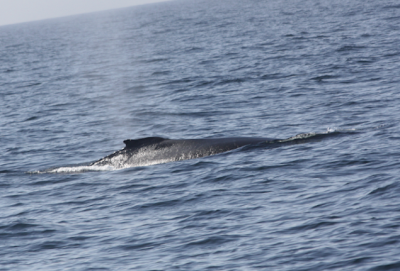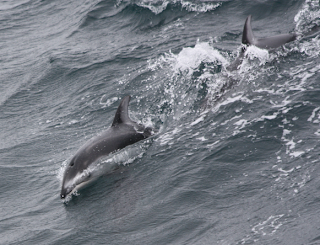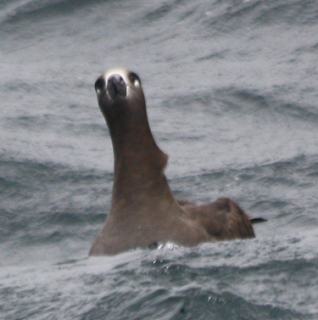27th April, 2013
A pelagic trip was scheduled today and it was no small ferry outing at longer than 12 hours. It required me to get up at 5:30am to leave harbour at 7am. We returned at 8:11pm. It was nothing compared to the pitiful 7-9 hours of previous trips I had joined.
 |
| Sunrise over Ventura harbour. |
The two colours of a perfect sunrise, orange and black, lit up the harbour. A caspian tern pair were borderline interesting, and a species I don't see super often.
 |
| Caspian tern (from an earlier trip). |
A little out a single Clark's Grebe accompanied a single Western Grebe. The rather limited beach held willet, grey plover, black oystercatcher and an American crow partaking in a bit of beach scavenging. Bottlenose dolphin made a brief presence in the small bay area.
Common murre soon became regular as the coastline was left in our wake. I had no doubt seen this species under the name guillemot in England several years ago, though I've never recorded it before. The lighting was not too great though. Scripp's murrelet and Cassin's auklet indulged us with erratic distant appearances. Cassin's in particular are challenging to find in the open sea, as a dark speck literally "the size of a tennis ball".
 |
| Bad lighting, bad... |
 |
| PENGUINS. No, not really. Scripp's Murrelet. |
The freshwater Black Tern seemed an oddity this far out to sea, but we encountered 4 in total on floating kelp patches. Rhinoceros Auklet started appearing too, though they weren't a big deal for me since I'd seen them much closer before. Humpback whales appeared in enough numbers to please a whale-watching trip.
 |
| No points for guessing why its called a Humpback Whale. |
The ashy storm-petrels appeared soon enough, though scattered again. A fork-tailed storm-petrel was called out by two people who saw it "fly right past the boat", and I was not one of them. It was not helpful that I was standing next to the person who saw it, while looking in the same direction! Bonaparte's gulls populated the empty space often held by western and Heerman's gull closer to shore, and the odd Sabine's Gull started appearing here and there. These gulls use the same colors scheme as all the other gulls but manage to look much more flashy.
Few on board were particularly interested in the white-sided dolphins that passed by. Usually the announcer calls out mammals even if there is minimal interest, but not for these ones. I'm lucky I was standing on the right side of the boat for them. They weren't too easy to find in the rough waters here, but the undulating seas made them more conspicuous than usual when they did breach.
 |
| Pacific White-sided Dolphin |
The target birds were albatrosses, the charismatic gliders that people often associate with the open ocean. The name translates to white wanderer, and how funny is it that my first albatross is infact not white at all. The black-footed albatross came in a pair and made an effort to approach the boat for the bait that was being thrown out to attract them. It is thought that the smell of these birds is quite good--when you are looking for food out in the desolate ocean there certainly is little chance of using even the best eyesight to spot the nearest food several miles away.
 |
Even though it has black feet, you'd think it would be named after something more obvious. Like, perhaps, the entire
colouration of the bird which clearly differs from the usual white species. |
The second albatross species was the
Laysan albatross, and a more typical looking member of the group. It is rarer in California waters.
The rest of the trip was remarkably quiet... But I must say nothing was quite as complete without the cupcake-shaped sunset.












No comments:
Post a Comment